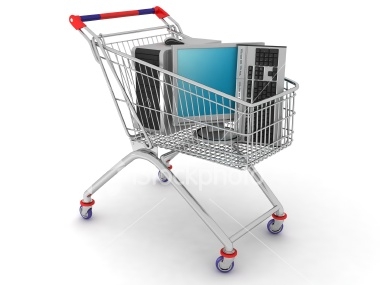Buying a new computer is no small task. Making the right choice requires more than just the knowledge of how fast a CPU runs, you need or how big a hard drive you want. You need to have a good idea of how you’ll use your new pc. Here are some things you should consider.
Before you go shop for a new desktop asks yourself this: what am I going to do with it?
Most people browse the web, check their email, send mail and juggle the occasional word documents or spreadsheet. Today you can use your phone for that. If you have particular needs like that it means you require storage. Pick a large hard drive with extra memory loading up with 4 GB of Ram.
Ready to burn Blue-ray discs r watch HD DVD Movies on it? Choose an optical drive that supports your preferred format.
The gaming Pc market continues to grow. If you’re a devoted gamer threes a pc that’s made for you. Such PCs usually feature over clocked CPUs and dual-graphics cards setups.
The processor.
If you plan to use for standard office productivity and basic internet tasks. Any processor will do. But if you’re looking for power an Intel core 2 duo chip is the best bet an AMD Athlon 64 x2 processer. It allows for fast multitasking and speedier performance on certain kinds of graphics and video apps. For maximum multitasking or when using multithread applications you may use quad-core CPUs such as 3 GHz Intel core2 extreme processor Qx6850 or dual-core 2.93 GHz core 2 extreme x6800 popular for power Pcs.
The memory
Make sure your motherboard has at least one or two USB ports on the front, to plug in your digital audio player and a USB memory drive, for example. You’ll want additional USB ports in back, for attaching everything from an external hard drive to a printer. Higher-end systems and Media Center PCs should also have audio/video inputs and FireWire ports within easy reach.
The other big news for PC enthusiasts is Intel’s “Skulltrail” motherboard. This enthusiast motherboard has dual LGA 771 CPU sockets that support the 45nm Penryn chips, and it also sports four x16 PCI Express 1.1 slots, two PCI 2.3 slots, six SATA 3.0 gbit/second ports, and two eSATA ports. In short: Whoa.
The case.
A good case can make your everyday work easier and can simplify the task of upgrading or servicing components–an especially valuable perk in offices with multiple systems. A well-designed case will offer tool-less access to the interior, hard drives mounted on easy-to-slide-out trays, and color-coded cables for internal and external parts.
If you plan to keep the system for a while, leave some room for expansion. You’ll want at least a couple of open drive bays and a free PCI slot as well. And since motherboards come in different shapes and sizes.
The hard drive.
Most business users don’t need a hard drive larger than 80GB, but for mixed use you’ll want more capacity. People who work with big databases, spreadsheets, or digital photo, music, or video files should think larger–drives are available in up to 750GB capacities. Two drives in a striped RAID 0 array can offer a boost in performance; alternatively you can get two drives mirrored together in a RAID 1 (or similar) configuration, to provide fault-tolerance against hardware failure.
Most drives today are Serial ATA and spin at 7200 rpm; serious gamers and other users who thrive on speed will appreciate the 10,000-rpm high-performance drives of Western Digital. The Western Digital Raptor X maxes out at 150GB, though, so you must make a trade-off in capacity to obtain the performance edge.
The monitor
Many people can get by just fine with a 17- or 19-inch LCD monitor, but we recommend buying a 22-inch wide-screen model, many of which now cost only a little more than their 19-inch counterparts do. Look for a digital monitor with DVI (you’ll enjoy a sharper image with digital) instead of an analog-only model (often, the sort that comes by default with the cheap PCs advertised online). Wide-screen monitors are an increasingly popular option, as are dual-monitor displays (if you want to go the latter route, look for a graphics card with dual-DVI ports).
Keyboard and Mouse.
Almost all systems include these commodity components, usually a Windows-compatible 102-key keyboard and a two-button mouse with a scroll wheel. Many vendors are switching from PS/2-connected devices to USB models that offer more features, such as additional programmable keys that can launch favorite applications or Web sites. Wireless keyboards and mice are also common; Windows Media Center PCs generally include wireless keyboards and mice, as well as a remote control.
Try to ensure that you get an optical mouse, which uses a small camera to detect motion and provides smoother, more precise control over cursor movement. Such models also eliminate the need for you to remove and clean a coated ball, as with older mice.
Operating system.
XP has been the biggest-selling operating system in the universe for almost half a decade now, so it’s where most of the action is. Whatever you long to do with a PC–accounting, blogging, photography, engineering, aimless wandering on the Internet–the necessary hardware and software will function under Windows XP.
Of course, to keep that copy of XP running smoothly, you’ll have to work to keep the wolves at bay. While Service Pack 2, Windows Security Center, and Internet Explorer 7 have closed a lot of holes, XP is sure to attract hackers and malware writers for years to come. Your firewall, antivirus software, and spyware protection remain as important as ever.
Windows Vista does deliver improvements in security (though you’ll still need a third-party firewall unless you’re up for some complex configuration tasks), plus several improved utilities and new features. It’s the look, though, that makes Vista a desirable upgrade for most people. Vista’s Aero environment displays windows, icons, and other desktop elements with more colors, shading, and shadowing, as well as–for the first time–transparency. Buttons glow like red or blue LEDs when you hover over them. Translucent window frames, menus, and title bars remind you of other applications buried a layer or two deep, and the Flip 3D task switcher is clearly inspired by Apple’s Exposé, which displays cleverly arranged thumbnails of all your running applications














